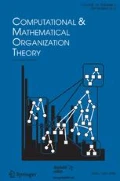Abstract
This article introduces a confidence level (CL) statistic to accompany the identification of the most central actor in relational, social network data. CL is the likelihood that the most-central actor assertion is correct in light of imperfect network data. The CL value is derived from a frequency-based probability according to perturbed samples of feature-equivalent network data. Analysts often focus attention towards the most central, highest valued, top actor [or node] according to one of four traditional measures: degree, betweenness, closeness or eigenvector centrality. However, given that collected social network data often has missing relational links, the correctness of the top-actor claim becomes uncertain. This paper describes and illustrates a practical approach for estimating and applying a CL to the top-actor identification task. We provide a simple example of the technique used to derive a posterior probability, then apply the same approach to larger, more pragmatic random network by using the results of an extensive virtual experiment involving uniform random and scale-free topologies. This article has implications in organizational practice and theory; it is simple and lays groundwork for developing more intricate estimates of reliability for other network measures.







Similar content being viewed by others
References
Bonacich P (1987) Power and centrality: a family of measures. Am J Soc 92:1170–1182
Borgatti SP (2006) Identifying sets of key players in a network. Comput Math Organ Theory 12:21–34
Borgatti SP, Carley KM, Krackhardt D (2006) On the robustness of centrality measures under conditions of imperfect data. Soc Netw 28:124–136
Calloway M, Morrissey JP (1993) Accuracy and reliability of self-reported data in interorganizational networks. Soc Netw 15:377–398
Carley Kathleen M (2006) Destabilization of covert networks. Comput Math Organ Theory 12:51–66
Carley K, Columbus D, DeReno M, Reminga J, Moon I-L (2008) *ORA user’s guide 2008. Carnegie Mellon University, School of Computer Science, Institute for Software Research, technical report, CMU-ISR-08-125
Costenbader E, Valente TW (2003) The stability of centrality measures when networks are sampled. Soc Netw 25:283–307
Feld SL, Carter WC (2002) Detecting measurement bias in respondent reports of personal networks. Soc Netw 24:365–383
Frantz T, Carley K (2005a) An automated methodology for conducting a social network study of a university faculty. Carnegie Mellon University, School of Computer Science (SCS), Institute for Software Research International (ISRI), Center for Computational Analysis of Social and Organizational Systems (CASOS)—technical report CMU-ISRI-05-106
Frantz T, Carley K (2005b) Relating network topology to the robustness of centrality measures. Carnegie Mellon University, School of Computer Science (SCS), Institute for Software Research International (ISRI), Center for Computational Analysis of Social and Organizational Systems (CASOS)—technical report CMU-ISRI-05-117
Frantz TL, Cataldo M, Carley K (2006) Social network data, given error: Evidence for the construction of confidence intervals around network measures. Presented at the International Network for Social Network Analysis, Sunbelt XXVI., Vancouver, British Columbia, April 25–30
Frantz TL, Cataldo M, Carley KM (2010) Robustness of centrality measures under uncertainty: examining the role of network topology. Comput Math Organ Theory 15(4):303–328
Freeman LC (1977) A set of measures of centrality based on betweenness. Sociometry 40:35–41
Freeman LC (1979) Centrality in social networks: I conceptual clarification. Soc Netw 1:215–239
Freeman LC, Rommey Kimball A, Freeman SC (1987) Cognitive structure and informant accuracy. Am Anthropol 89:310–325
Galaskiewicz J (1991) Estimating point centrality using different network sampling techniques. Soc Netw 13:347–386
Gest SD, Graham-Bermann SA, Hartup WW (2001) Peer experience: common and unique features of number of friendships, social network centrality, and sociometric status. Soc Dev 10(1):23–40
Gile K, Handcock MA (2006) Model-based assessment of the impact of missing data on inference for networks. Working paper, no. 66, Center for Statistics and Social Sciences, University of Washington
Granovetter M (1976) Network sampling: some first steps. Am J Soc 81:1287–1303
Handcock MS, Gile K (2007) Modeling social networks with sampled or missing data. Working paper, no.75, Center for Statistics and Social Sciences, University of Washington
Kempe D, Kleinberg J, Tardos É (2003) Maximizing the spread of influence through a social network. In Proceedings of the ninth ACM SIGKDD international conference on knowledge discovery and data mining. ACM, pp 137–146
Killworth PD, Bernard HR (1976) Informant accuracy in social network data. Hum Organ 35:269–286
Kim PJ, Jeong H (2007) Reliability of rank order in sampled networks. Eur Phys J B 55:109–114
Kossinets G (2006) Effects of missing data in social networks. Soc Netw 28:247–268
Marsden PV (1990) Network data and measurement. Ann Rev Soc 16:435–463
Papaioannou T, Loukas S (1984) Inequalities on rank correlation with missing data. J R Stat Soc, Ser B 46:68–71
Robins G, Pattison P, Woolcock J (2004) Missing data in networks: exponential random graph (p∗) models for networks with non-respondents. Soc Netw 26:257–283
Stork D, Richards WD (1992) Nonrespondents in communication network studies: problems and possibilities. Group Organ Manag 17:193–209
Zemljic A, Hlebec V (2005) Reliability of measures of centrality and prominence. Soc Netw 27:73–88
Author information
Authors and Affiliations
Corresponding author
Rights and permissions
About this article
Cite this article
Frantz, T.L., Carley, K.M. Reporting a network’s most-central actor with a confidence level. Comput Math Organ Theory 23, 301–312 (2017). https://doi.org/10.1007/s10588-016-9229-x
Published:
Issue Date:
DOI: https://doi.org/10.1007/s10588-016-9229-x




